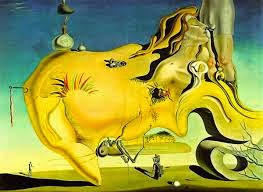SALVADOR DALI's MIND BLOWING WORLD - PART 1
Salvador Dali - Agent Provocateur of Modern Art
"Every morning, upon awakening, I experience a supreme pleasure: that of being Salvador Dali, and I ask myself, wonderstruck, what prodigious thing will he do today, this Salvador Dali."
Salvador Dali
"Every morning, upon awakening, I experience a supreme pleasure: that of being Salvador Dali, and I ask myself, wonderstruck, what prodigious thing will he do today, this Salvador Dali."
Salvador Dali
#1 Landscape Near Figueras (1910)
This is one of the earliest known works by Dalí, having been painted when he was about six years old. At the beginning of Dalí's career, his primary influence was from the Impressionist movement.[source]
#2Vilabertran (1913)
This is among Dalí's earliest works, having been painted when he was about nine years old. It is a landscape painting from Vilabertran as Dalí often drew in his early period.[source]
#3 Cabaret Scene (1922)
This was a unique cubist experiment that came between Dalí's early impressionist work and the classic surrealist technique he would later develop.[source]
#4 The Basket of Bread (1926)
The Basket of Bread was created when Dali was 22, during his last months at art school in Madrid. He created this work as a test for himself – to prove his technical skill as a painter by demonstrating his ability to create the intense realism achieved by his artistic role models, particularly Jan Vermeer.[source]
#5 Apparatus and Hand (1927)
This is an oil on panel which is a clear example of the Surrealistic style, for which Dalí was very famous for. This is basically a depiction of a geometric shape made of triangles and cones, out of which one can see a red hand coming out from the top part. Around this shape one can see a number of nude women and torsos on a light blue background. On the left one can see a donkey on its hind legs with several flies on him. This is regarded as an indication that ultimately even the apparatus is bound to degrade and decompose in time, just like any other creature.[source]
#6 The Great Masturbator (1929)
The center of the painting has a distorted human face in profile looking downwards, based on the shape of a natural rock formation at Cap de Creus along the sea-shore of Catalonia.[source]
#7 The First Days of Spring (1929)
Dali says, “I spent the whole day seated before my easel, my eyes staring fixedly, trying to ‘see,’ like a medium…the images that would spring up in my imagination.” Few paintings demonstrate the hallucinatory results better than The First Days of Spring. Painted just a few months prior to his joining the Surrealist movement, it presents many of the Freudian symbols and irrational details that characterize his Surrealist period.[source]
#8The Lugubrious Game (1929)
In this painting he is overwhelmed with content that may not always fall upon the same subject matter. Not to say that within his paintings the subject matter is always related. Dali has joined a community which ultimatley sacrafices some of his isolation as an artist and as a person.[source]
#9 Illumined Pleasures (1929)
The imagery, realized through a combination of painting and collage, refers to personal and universal dreams and anxieties. Dalí's own disembodied head appears in the middle box, while an allegory of castration anxiety plays out below.[source]
#10 The Persistence of Memory (La persistencia de la memoria-1931)
Although it was conjectured that the soft melting watches were the result of Dali’s interpretation of the theory of relativity, Dali himself state that their inspiration was camembert cheese melting under the sun. The sequence of melting clocks in a disjointed landscape is the depiction of a dream that Dali had experienced, the figure in the middle of the painting being the face of the dreamer himself.[source]
#11 The Ghost of Vermeer of Delft Which Can Be Used As a Table (1934)
It makes reference to The Art of Painting by Johannes Vermeer, a famous seventeenth-century work in which a painter, thought to be a self-portrait of Vermeer, is depicted with his back to us, in distinctive costume. It is one of a number of paintings expressive of Dalí's enormous admiration for Vermeer.[source]
#12 Soft Construction with Boiled Beans (Premonition of Civil War) (1936)
Dali painted this work prior to General Franco's invasion, yet it predicts the violence, anxiety, and doom many Spaniards felt during Franco's later rule. Soft Construction with Boiled Beans is a fine example of a Dali composition that simultaneously expresses his sexual obsessions as well as his political outrage.[source]
#13 Morphological Echo (1934-1936)
It depicts a seemingly minimal architectural setting with several surrealist images in its finer details. In the distance is a wall housing a bell resembling the figure of a woman in bundled skirts. In the distance towards the center is a strangely eroded rock form. The most significant element of this image is a small figure in the lower right of a woman running with a large hoop. In the shadow cast by the figure, her arms appear to merge into a circle around her head. The shadow cast by the figures head takes on the appearance of the hub of a wheel.[source]
#14 Swans Reflecting Elephants (1937)
The swans and the twisted trees are reflected in the lake as elephants. Dali called this technique paranoiac-critical, where hallucination and reality seem to merge.[source]
#15 Metamorphosis of Narcissus (1937)
Narcissus was a youth of great beauty who loved only himself and broke the hearts of many lovers. The gods punished him by letting him see his own reflection in a pool. He fell in love with it, but discovered he could not embrace it and died of frustration. Relenting, the gods immortalised him as the narcissus (daffodil) flower.[source]
Which one is your favorite and why?












_jpg!Blog.jpg)



No Comment to " SALVADOR DALI's MIND BLOWING WORLD - PART 1 "